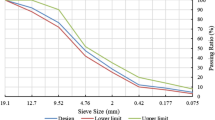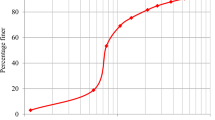A complex of physicochemical studies was conducted: chemical analysis, x-ray phase analysis, differential thermal analysis, microstructure analysis of ash-slag waste (ASW) from Apatitskaya CHPP and Severodvinskaya TPP-1. It has been established that these materials are promising raw materials for the silicate industry, because in terms of structure as well as chemical and phase composition they represent an amorphous aluminosilicate composition that does not undergo phase transformations during heat treatment. ASW can be used in the production of temperature-curable eco-geopolymers for road construction in the Arctic zone of the Russian Federation.





Similar content being viewed by others
References
Federal Law of July 13, 2020 No 193-FZ “On state support for entrepreneurial activity in the Arctic zone of the Russian Federation,” Ross. Gazeta, July 16, 2020, No. 155(8209).
M. A. Zhukov, “Methodological and methodical problems of identifying the Arctic zone of the Russian Federation,” Arktika XXI Vek. Gumanitarnye Nauki, No. 1(2), 4 – 20 (2014).
N. Didenko, D. Skripnuk, and D Rudenko, “Environmental security issues in the Russian arctic,” in: International Multidisciplinary Scientific GeoConference Surveying Geology and Mining Ecology Management, SGEM 2015, Albena, 18 – 24 June 2015, Albena (2015), pp. 267 – 274.
O. Yu. Krasulina, “Characteristics of human life environments in the Arctic geoeconomic space,” in: Economic Restructuring and Engineering Education: Problems and Development Prospects: Scientific Articles from Scientific-Practical Conference, Engineering and Economic Institute SPbPU, St. Petersburg, May 27, 2015 [in Russian], St. Petersburg (2015), pp. 380 – 386.
N. I. Didenko and D. F. Skripnyuk, “Modeling of sustainable socio-economic development of the regions of the Arctic space of the Russian Federation using a system of econometric equations,” in: Strategic Priorities for the Development of the Russian Arctic [in Russian], Nauka, Moscow (2015).
E. A. Yatsenko, B. M. Gol’tsman, V. A. Smolii, et al., “Study on the possibility of applying organic compounds as poreforming agents for the synthesis of foam glass,” Glass Phys. Chem., 45(2), 138 – 142 (2019).
V. A. Smolii, A. S. Kosarev, E. A. Yatsenko, and B. M. Gol’tsman, “Structure formation in cellular glass based on Novocherkassk CHPP ash – slag wastes,” Glass Ceram., 75(7 – 8), 303 – 307 (2018) [Steklo Keram., No. 8, 20 – 24 (2018)].
E. A. Yatsenko, V. A. Smolii, A. S. Kosarev, and B. M. Gol’tsman, “Foamed slag glass – eco-friendly insulating material based on slag waste,” in: 15th IEEE International Conference on Environment and Electrical Engineering, Rome, Italy, 10 – 15 June 2015, Rome (2015), pp. 819 – 823.
V. A. Smolii, E. A. Yatsenko, B. M. Gol’tsman, and A. S. Kosarev, “Influence of granulometric composition of batch on technological and physical-chemical properties of granular porous silicate aggregate,” Glass Ceram., 74(7 – 8), 270 – 272 (2017) [Steklo Keram., No. 8, 12 – 14 (2017)].
A. V. Ryabova, T. A. Es’kova, N. S. Karandashova, et al., “Development of a method for improving the performance properties of glass-enamel coatings for steel,” Glass Ceram., 71(9 – 10), 327 – 329 (2015) [Steklo Keram., No. 9, 32 – 35 (2014)].
N. I. Vatin, D. V. Petrosov, A. I. Kalachev, and Lakhtinen Pentti, “The use of ash and ash and slag waste in construction,” Inzh.-Stroit. Zh., No. 4, 16 – 21 (2011).
A. A. Gerasimova and R. B. Khamraeva, “Creation of waste-free production of ash and slag waste (ASW),” Aktual. Probl. Aviatsii Kosmonavtiki, 2[4(14)], 674 – 676 (2018).
R. S. Kamil’chu and S. V. Tsybakin, “Application of ash and slag waste in the production of concrete and mortar,” in: S. V. Tsybakin, M. A. Ivanova, and A. V. Rozhnov (eds.), Actual Problems of Science in the Agro-Industrial Complex: 71st Intern. Scientific-Practical Conf., in 3 vols. (2020), Vol. 2, pp. 43 – 47.
A. S. Anisimov, “Methods of processing ash and slag waste from CHPPs,” in: Tinchurinskie Readings – 2020, Energy and Digital Transformation, Inter. Youth Scientific. Conf., in 3 vols., Kazan, April 28 – 29, 2020 [in Russian], Kazan (2020), Vol. 2, pp. 485 – 487.
F. F. Bryukhan’, “Use of ash and slag waste from coal-fired heat-and-power plants for the production of building materials,” in: Actual Problems of the Construction Industry and Education, First National Conference, Moscow, 30 Sept. 2020, Moscow (2020), pp. 225 – 228.
A. V. Yavinskii and I. L. Chulkova, “Processing of ash and slag waste for the production of road slabs,” in: Education. Transport. Innovation. Construction: 3rd National Scientific-Practical. Conf., Omsk, 23 – 24 Apr. 2020 [in Russian], Omsk (2020), pp. 631 – 636.
E. A. Yatsenko, V. A. Smolii, B. M. Gol’tsman, and E. A. Yatsenko, “Perspective and experience of use of glass fraction of solid municipal waste in the production of silicate heat-insulating materials,” in: 2018 IEEE International Conference on Management of Municipal Waste as an Important Factor of Sustainable Urban Development (WASTE), St. Petersburg, Russia, 4 – 6 Oct. 2018 [in Russian], St. Petersburg (2018), pp. 46 – 48; URL: https://ieeexplore.ieee.org/document/8554153/
V. A. Smolii, A. S. Kosarev, and E. A. Yatsenko, “Ash-slag based cellular glass for energy-efficient 3-ply construction panels,” Glass Ceram., 76(3 – 4), 105 – 108 (2019) [Seklo Keram., No. 3, 28 – 32 (2019)].
L. Ya. Shubov, K. D. Skobelev, I. G. Doronkina, and D. A. Zagorskaya, “Technological aspects of creating market conditions for the involvement of ash and slag waste in processing and disposal,” Ekol. Sistemy Pribory, No. 10, 36 – 44 (2019).
L. Ya. Shubov, K. D. Skobelev, I. G. Doronkina, and K. E. Dubrovin, “On the use of ash and slag waste from CHPP in road construction,” Ekol. Prom. Proizv-va, No. 1(109), 6 – 9 (2020).
E. I. Shamrai, A. V. Taskin, S. I. Ivannikov, and A. A. Yudakov, “Study of the possibilities of integrated processing of waste from energy enterprises of the Primorskii Krai,” Sovr. Naukoemkie Tekhn., No. 3, 68 – 75 (2017).
V. E. Klimov, “Use of dumped ash and slag waste obtained by burning coal from the Kuznetsk basin as an active mineral additive to cement (for example, ash and slag from the Novo-Kemerovo CHPP),” ALITinform: Taement, Beton, Sukhie Smesi, No. 3, 38 – 47 (2010).
Acknowledgement
This work was performed at SRSPU (NPI) with the financial support of the Russian Science Foundation under agreement No. 21-19-00203 ‘Effective temperature-cured eco-geopolymers for road construction in the Arctic zone of the Russian Federation based on solid fuel combustion waste from local thermal power plants’ (supervisor E. A. Yatsenko).
Author information
Authors and Affiliations
Corresponding author
Additional information
Translated from Steklo i Keramika, No. 9, pp. 40 – 44, September, 2021.
Rights and permissions
About this article
Cite this article
Yatsenko, E.A., Smolii, V.A., Klimova, L.V. et al. Solid Fuel Combustion Wastes at CHPP in the Arctic Zone of the Russian Federation: Utility in Eco-Geopolymer Technology. Glass Ceram 78, 374–377 (2022). https://doi.org/10.1007/s10717-022-00414-3
Published:
Issue Date:
DOI: https://doi.org/10.1007/s10717-022-00414-3




